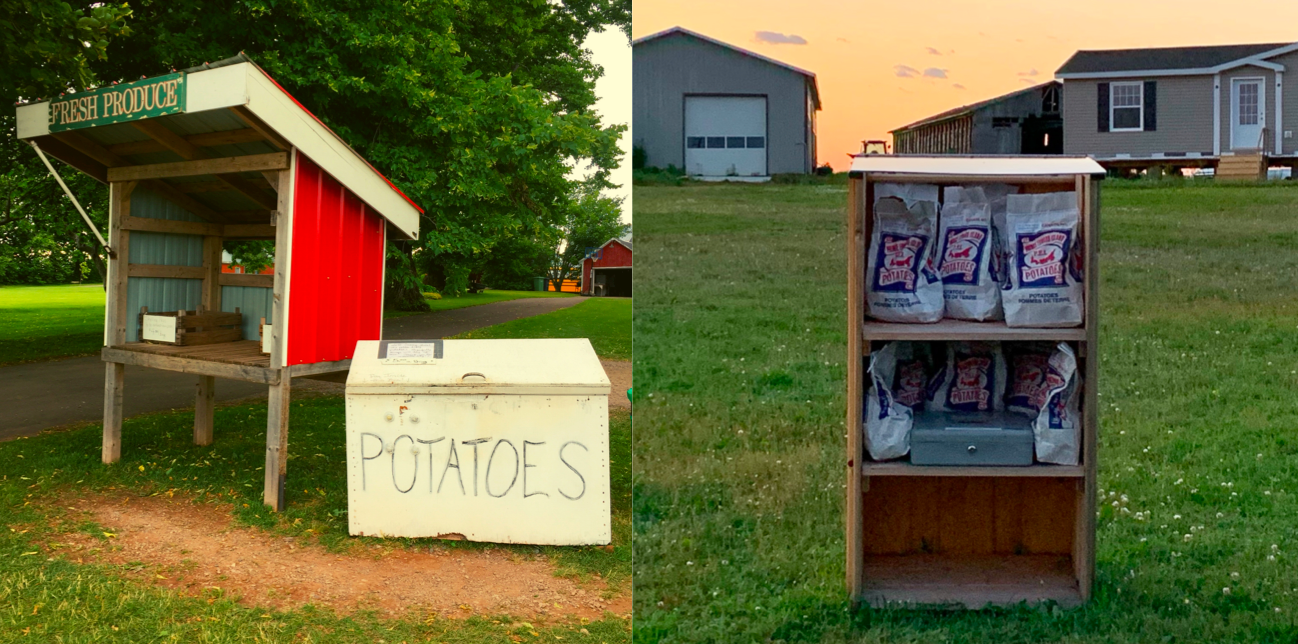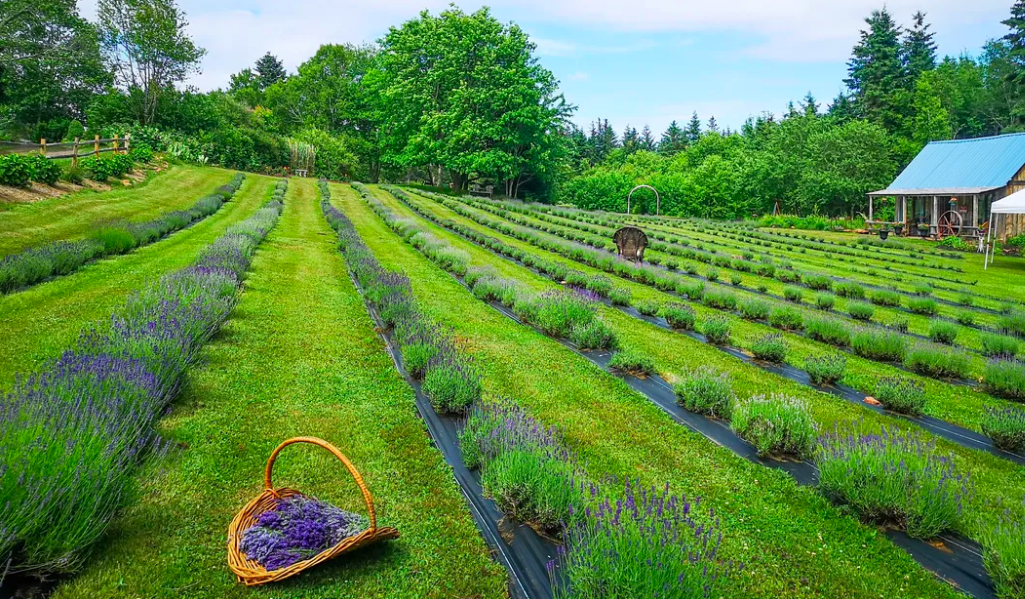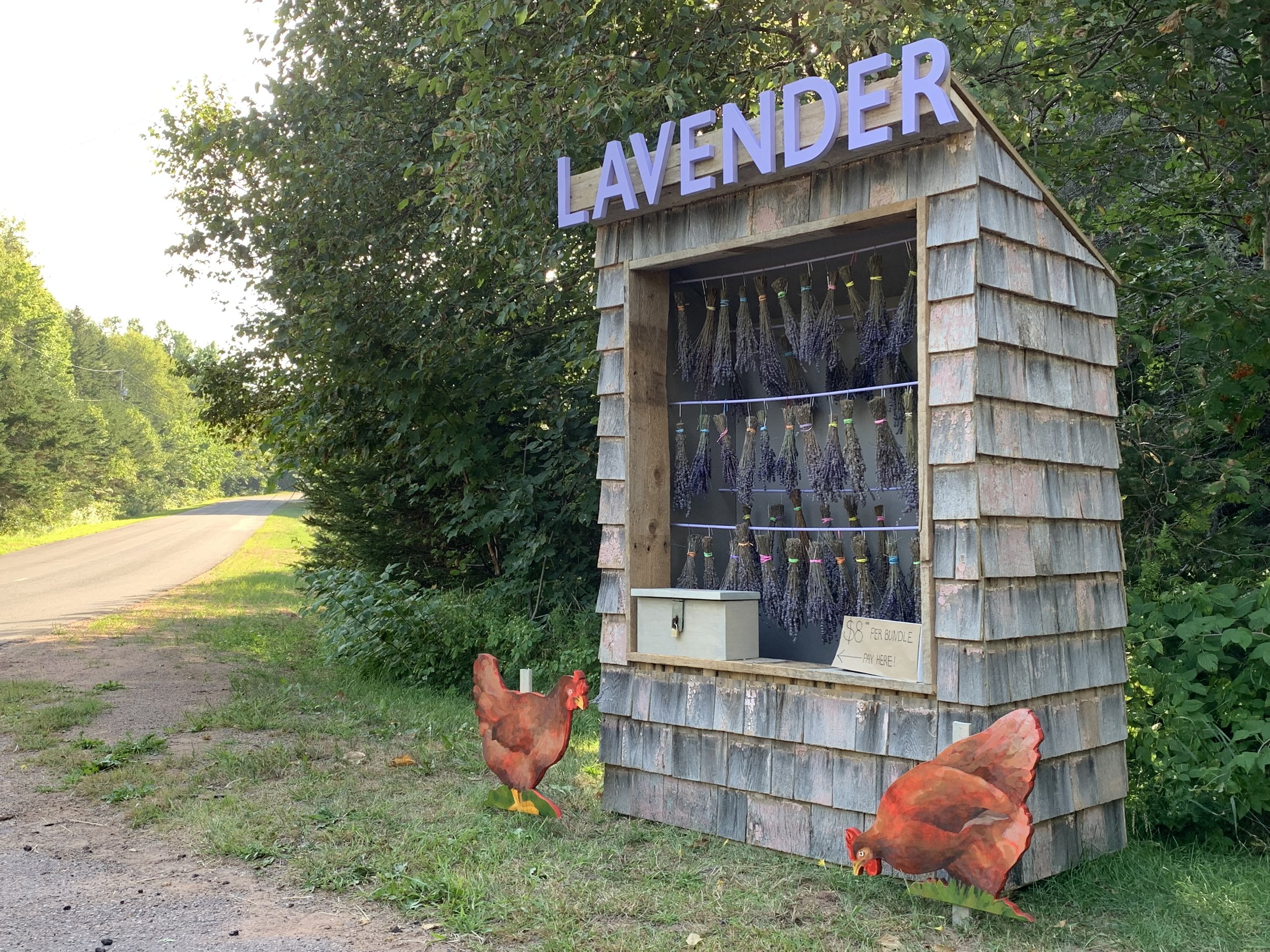This is the sixth installment in a series of blog posts by ClimateSense Intern Alexis Bulman, who is sharing monthly insights into her research, creative process and artistic explorations as she works with us to develop community-engaged artworks and programming around climate change adaptation.
I’ve been enthralled by PEI’s road-side produce booths for many years, and even more so since my ClimateSense position began.
Produce booths are structures at the end of farm driveways that proudly display the produce grown there. A booth may have a prominent heap of corn, bags of potatoes, an abundance of pumpkins, etc. Most iconically, these booths are never staffed; instead there’s an honor system in which a box is secured to the booth and the customer is expected to drop in their money and leave with only the quantity of produce they paid for. The trust and sharing aspect of these booths are so charming!
Two photos side by side. The left photo depicts a white container with a silver lid, on the front four black letters spell out “beans”. The container rests on two wooden beams with four black tires affixed beneath, surrounded by a grassy landscape with blue sky. Right photo shows a red building with white trim, surrounded by pumpkins and an autumn landscape. A white sign reads “Please pay here, thank you”
I’ve come to appreciate these booths for their DIY aesthetics too, as well as their functionality, rural locations and for their sense of happenstance. The booths popup around the island at different times, depending on what their crop is and when it’s harvested. If a crop has done especially well it may have a booth for the first time, and sometimes when you arrive, the booth’s stock has already been depleted for the day. All of these factors make finding a stocked produce booth feel like an event.
Two photos side by side. Left photo: a blue booth with lettering that reads “mushroom for sale u-pick”, inside are two wooden shelfs with a yellow sign and a cooler. Leading to the booth is a pallet walk-way, surrounding landscape is of grass and trees. Right photo: a black folding table with stalks of rhubarb on it, to it’s right is a wooden sign with blue painted letters “Rhubarb $3/lb or 2 lb for $5", surrounded by grass with a dirt driveway in the background
When I began my ClimateSense position almost a year ago, I read the Prince Edward Island Climate Change Adaptation Recommendations Report, published by The University of Prince Edward Island’s Climate Research Lab.
This article outlined how climate change will have a significant impact on the present and future of island agriculture. There will be more hot days, and a change in precipitation patterns leading to increased drought. PEI’s agriculture industry will have to adapt and shift away from familiar crops to crops that are better suited for warmer, drier conditions, such as winter cereals (zorza, chickpeas & lentils), sweet cherries, grapes, lavender, hascaps and more.
After reading that article my mind flashed back to the road-side produce booths I’d been fixated on, and I began to think of them as portraits of agriculture, and then I began to wonder what these portraits might look like in the near future.
Two photos side by side. Left photo depicts a red produce booth with white trim, wooden legs and a green sign that reads “Fresh Produce”. Next to the booth is a white coolers with “POTATOES” written in black marker. A farm and farmyard fill the background. Right photo: A wooden shelf lined with sacks of potatoes and a silver cash box is centered in the photo, behind it are three grey buildings, grass and a golden sunset
With the support of UPEI ClimateSense and a PEI Arts Grant, I decided to start Future Booths, a body of work that would encompass three elaborate produce booth art installations. Future Booths would embody a form following function approach, meaning the design of each will be inspired and informed by the crop, farm and location. Each booth will embody the DIY aesthetic and honor payment system iconic to traditional PEI produce booths and would feature adaptive agriculture. While working on this project, I also made an effort to stop and document produce booths around the island.
A landscape photograph depicts a field of green grass with rows of purple lavender plants, a horizon of trees, a wooden fence to the left, a green-roofed building to the right and a basket of picked lavender in the foreground
For the first Future Booth I contacted the Islander Lavender Distillery and after pitching the art project to them, they invited me to tour their lavender farm. The farm was an oasis of open fields planted with rows and rows of purple lavender, and situated around the fields were some rustic wooden buildings and red-feathered hens roaming freely. In July, the farm operates as a fresh lavender u-pick, so we decided a produce booth displaying bundles of dried lavender could extend their season by an additional two months. With that in mind, I got to work in my sketchbook.
Two pages of a sketchbook with a coiled spine down the middle. Left page shows four lavender paint chips and numerous pen sketches of a building. Right page shows a black pen drawings of a wooden lavender booth with a hen in the foreground
I drew plans for a booth that incorporated the aesthetic of the farm. I used lavender paint for the ‘Lavender’ sign, included a few hens, found some old barn boards and weathered cedar shingles to up-cycle and built a booth that would display hundreds of dried lavender bundles while keeping them shaded from the sun. The booth was installed at the end of Apple Tree Lane in Bonshaw in August, and remained installed until October 31st. 100% of the proceeds went to the farmers of Island Lavender Distillery.
A landscape photograph shows a lavender-stocked produce booth to the right-hand-side with a sign atop it that reads "lavender” and two red painted hens out front. In the left-hand-side of the photo a road spotted with sunlight vanishes behind some trees
Two photos side-by-side. left photo depicts rows of hanging bundles of lavender, each bound by a colorful elastic rubber band. Right photo depicts a red painted hen, behind it are rustic painted cedar shingles on a close-up building
For the second Future Booth, I wanted to select a crop that would ignite the curiosity of islanders, and soon enough I found it while driving past Red Island Cidery and saw their promotional signage for a Quince cider. Curious, I contacted the owner and learned that many island orchards were beginning to plant quince trees along with their apples and pears because it can yield fruit with less water and in warmer climates. So again, I got to work in my sketchbook.
Two sketchbook pages divided by a black coiled spine in the center. left page has black pen drawings of fruit signage, and two yellow marker drawings in the shape of fruit, one reads “QUINCE” in brown the other reads “10 for a toonie” in black. Right page shows a carefully rendered color pencil drawing of a big piece of yellow fruit surrounded by a basket and plants, all resting on a black circle
Quince trees bear a deciduous pome fruit, similar to a pear but smaller and lumpier, and bright golden-yellow when mature. The unusual shape and bright color of quince immediately made me want to create a large, kitschy quince sculpture, similar to a fiberglass attraction at an amusement park. Quinces are small, so I designed an art installation that would be petite so as to not overwhelm the fruit. The quince were displayed in a breathable basket so that air flow would prevent rotting and encourage continual ripening. I also wanted to repeat the round motif of the quince throughout the installation, and lean into an autumn aesthetic, so I chose a circular mulch flower bed, a rounded basket, curvy lettering with several circular bouquets of planted yellow, orange and white mums.
A photograph of a large yellow sculpture of Quince fruit surrounded by yellow, orange and white mum plants, and a two-toned woven basket containing quine fruit, tongs and brown paper bags. Situated beside the quince sculpture is a sign on a post with three yellow planks of wood, the first one reads “Quince” in light letters, the plank below it reads “Delicious in Jams, jellies and tarts!” in black letters, and below it the last plank reads “10 for $2” in light letters. The entire display rests on a circular black bed of multch and is surrounded by grass and trees
Two photographs side-by-side. Left photograph is a close up on a yellow quince sculpture and a sign on a post with three yellow planks of wood, the first one reads “Quince” in light letters, the plank below it reads “Delicious in Jams, jellies and tarts!” in black letters, and below it the last plank reads “10 for $2” in light letters. Right photo is a close up on two hands, one hand holds a brown paper bags and the other is using silver tongs to take a yellow quince out of a basket of fruit. Grass, black mulch, trees and flowers are visible in the background
I had the pleasure of installing the quince Future Booth during The River Clyde Pageant’s inaugural Sharing the Field event at The Mill in New Glasgow during the first weekend of October.
I hope to make many more Future Booth art installations because it’s been a great experience to create art that celebrates the functionality and modest absurdity of traditional road-side produce booths while sparking conversations about adaptive and sustainable farming in PEI, in the rural communities where change is already happening! The project may be called Future Booths, but climate change is a concern of the present and future - change is happening and adaptation is necessary to ensure food security on PEI and around the world.
If you have a new crop, contact me! I’m already itching to build more art installations in this series!









